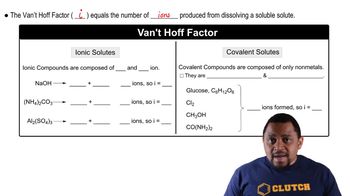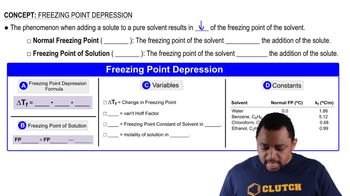Here are the essential concepts you must grasp in order to answer the question correctly.
van't Hoff Factor (i)
The van't Hoff factor (i) is a measure of the number of particles into which a solute dissociates in solution. For ionic compounds, this factor is crucial for calculating colligative properties, such as freezing point depression and boiling point elevation. For K2SO4, which dissociates into two potassium ions (K+) and one sulfate ion (SO4^2-), the van't Hoff factor is 3.
Recommended video:
Freezing Point Depression
Freezing point depression is a colligative property that describes how the freezing point of a solvent decreases when a solute is added. The extent of this depression is directly proportional to the molality of the solution and the van't Hoff factor. The formula ΔTf = i * Kf * m is used, where ΔTf is the change in freezing point, Kf is the freezing point depression constant, and m is the molality of the solution.
Recommended video:
Freezing Point Depression
Mass Percent Concentration
Mass percent concentration is a way to express the concentration of a solution, defined as the mass of solute divided by the total mass of the solution, multiplied by 100. In this case, a 5.00% K2SO4 solution means that there are 5 grams of K2SO4 in 100 grams of solution. This information is essential for calculating the molality and subsequently the van't Hoff factor in the context of colligative properties.
Recommended video:




